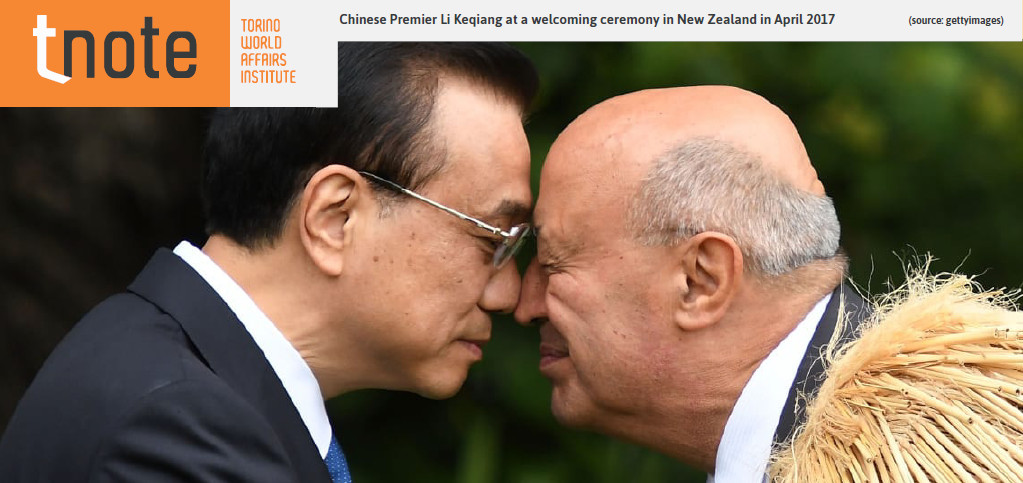
New Zealand is a country that champions multilateralism. It was one of the original planners of the Trans-Pacific Partnership (TPP) and it is involved in talks on the Regional Comprehensive Economic Partnership (RCEP). New Zealand has close ties with Europe, holds free trade deals with many countries in Asia, and – having the largest Polynesian population in the world – has intimate links with other Pacific island states. And despite superpower tensions between the United States and China, New Zealand is on friendly terms with both of them: it shares intelligence with the United States; and Chinese investors are rapidly gobbling up real estate and making Mandarin a common tongue in major cities.
New Zealand promotes multilateralism because it needs it to survive. As a small island economy in the bottom of the Pacific – its population is less than five million and its closest big neighbor, Australia, is over a three-hour flight away – being connected to other countries through trade and investment is New Zealand’s lifeblood. A formative moment in New Zealand becoming so multilateral occurred two generations ago, when the United Kingdom joined the European Economic Community, abolishing Britain’s preferential links to Commonwealth primary good providers. New Zealand was unexpectedly left adrift, realizing that, if it could no longer depend on its former imperial capital, it needed to put its bet on as many horses in the race as it could.
Given such a phobia of dependence, New Zealand therefore perceives China’s expansionism, and specifically the Belt and Road Initiative (BRI), with some apprehension. This is because BRI is fundamentally a collection of bilateral deals. No matter how attractively China packages it for other countries, no one doubts that BRI is a hub-and-spoke strategy with China at its core. Bilateral deals are dangerous for small trade-dependent countries. If New Zealand is the weaker partner, as it certainly is in the bilateral relationship with China, this opens up the possibility for China’s meddling with its autonomy.
At the same time, though, New Zealand’s survival depends on being involved in as many networks as possible. It cannot afford to be overly selective and BRI offers great opportunities. Particularly as an export destination for foodstuffs, China is a match made in heaven. China has many mouths to feed, and an increasing number of rich consumers there demand quality produce, meat, and dairy products. New Zealand, on the other hand, is known for its world-class edible products, which are selling well in China.
New Zealand has already committed itself to friendly relations with China anyway. It was the first country to agree to China’s accession to the World Trade Organization (WTO) in 1997, the first country to recognize China as a market economy in 2004, the first developed country to commence bilateral free trade negotiations with China in 2004, and the first country to conclude a free trade negotiation with China in 2008 (which is now in the process of upgrading). But this is not to oversimplify – the advantages of the New Zealand-China relationship go two ways. A significant benefit for China is that by working with a small, Western country like New Zealand in a non-threatening way, it can advertise to the rest of the world what a benign hegemon it is and thereby increase its soft power.
At the same time, New Zealand will look to use BRI to its own advantage in ways that do not lead to overdependence on China, and it will therefore seek to involve more countries in the Asia-Pacific’s economic infrastructure. With BRI, New Zealand will examine options to use the project not just to deepen ties with China, but also to deepen ties with other countries along the BRI “spoke” where it is located. When Chile and Argentina’s leaders attended the BRI summit last year, this opened an opportunity for New Zealand to transform itself into a stepping stone between Southeast Asia and South America. If China’s economic activity in the South Pacific grows, New Zealand can similarly act as an access point to smaller island countries like Tonga and Samoa.
New Zealand is furthermore keen to deepen ties with the Association of Southeast Asian Nations (ASEAN) as a way to improve autonomy – the bloc is a convenient potential neutral zone between increasingly antagonistic superpowers – and BRI can serve to strengthen ASEAN. Beyond the bureaucratic challenges of creating common laws, regulation, and coordination, the bloc’s main obstacle to development is the physical one of developing infrastructure networks: Thai companies, for instance, can expand into Myanmar with Singaporean financial support only if there are road, rail, and maritime linkages between Myanmar and the rest of ASEAN. BRI is clearly poised to support developing such infrastructure projects, provided that they also connect Southeast Asia back to southern China. New Zealand sees this potential for BRI to elevate ASEAN, and in so doing create a new market in Southeast Asia for New Zealand exports.
All told, New Zealand sees China’s expanding influence with apprehension, but it also sees BRI as a deal too good to pass up. So New Zealand will likely deepen its relations with China going forward. New Zealand is a small country that cannot influence how the tectonic plates of geopolitics align themselves. Its task, instead, is to stay on good terms with everyone and to use the global order to its benefit as much as possible. Given that China seems poised to continue gaining prominence, therefore, New Zealand is more than happy to figure out how to make this trend work to its advantage.
Download

Copyright © 2024. Torino World Affairs Institute All rights reserved
